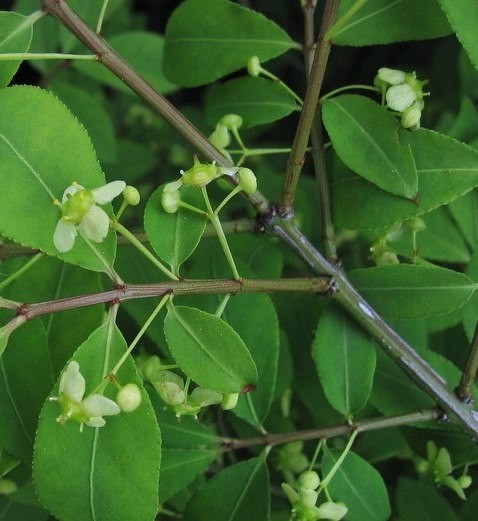Winged spindle
(Euonymus alatus alatus)

Description
Euonymus alatus, known variously as winged spindle, winged euonymus, or burning bush, is a species of flowering plant in the family Celastraceae, native to central and northern China, Japan, and Korea. The common name "burning bush" comes from the bright red fall color. It is a popular ornamental plant in gardens and parks due to its bright pink or orange fruit and attractive fall color. The species and the cultivar 'Compactus' have both gained the Royal Horticultural Society's Award of Garden Merit. This plant is regarded as an invasive species of woodlands in eastern North America, and its importation and sale is prohibited in the states of Massachusetts, New Hampshire, and Maine. This deciduous shrub grows to 6.1 m (20 ft) tall, often wider than tall. As with the related Euonymus phellomanus, the stems are notable for their four corky ridges or "wings." The word alatus (or alata, used formerly) is Latin for "winged," in reference to the winged branches. These structures develop from a cork cambium deposited in longitudinal grooves in the twigs' first year, unlike similar wings in other plants. The leaves are 2–7 cm (3⁄4–2+3⁄4 in) long and 1–4 cm (1⁄2–1+1⁄2 in) broad, ovate-elliptic, with an acute apex. The flowers are greenish, borne over a long period in the spring. The fruit is a red aril enclosed by a four-lobed pink, yellow, or orange capsule Detail of leaves in autumn All parts of the plant are toxic by ingestion, causing severe discomfort. Euonymus alatus native distribution extends from northeastern Asia to central China. Besides central and eastern China, Euonymus alatus also appears in Korea, Japan, and the Sakhalin islands of eastern Russia. In its native areas, Euonymus alatus occurs in forests, woodlands, and scrublands from sea level to 8,900 feet elevation. The Euonymus alatus plant is nonnative to North America. In the United States, burning bush is found in New England, as well as Illinois, and extends south to northern Florida and the Gulf Coast. It is currently considered an invasive species in 21 states.
Taxonomic tree:







